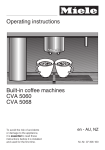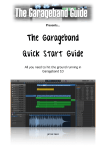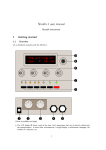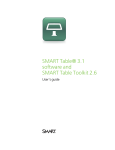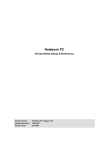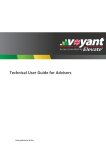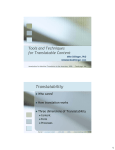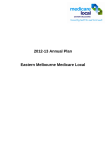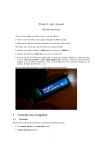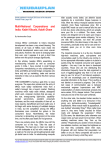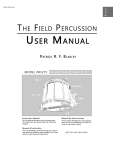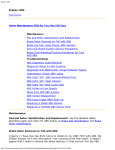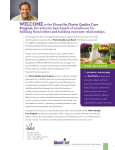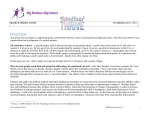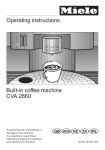Download User manual 1
Transcript
the Combo Class – user manual workbook 1 Martin Boere the Combo Class – user manual workbook 1 M. Boere 2015 Editing by Rob Boere 1st edition, published by Stichting MuzieKlas, Nijmegen, the Netherlands 1 the Combo Class – user manual workbook 1 Content preface 3 unit 1 learning content 4 introduction 5 instruments and playing exercises 7, 8 en 9 26 jump 28 mix 29 ranunculus, Jumbo’s dance 30 invention 3 30 completion of unit 3 31 techniques 5 rules of the game 6 unit 4 exercises (function) 6 learning content 32 exercise 1 6 exercises 10, 11 and 12 32 exercises 2 and 3 8 transpose 33 games (function) 9 empty square, far away copy 10 from home 33 search 11 invention 4 33 instruction 12 completion of unit 4 33 notation 13 assessment 34 metre 13 repertoire pieces 13 what’s the deal?, I guess so! 14 inventions 14 invention 1 15 completion of unit 1 17 unit 2 learning content 20 exercises 4, 5 en 6 20 locomotive 22 thread 22 the tone system 22 keyboard and guitar guide 23 Sally’s weeping, who knows 23 invention 2 24 completion of unit 2 24 assessment 24 unit 3 learning content 26 2 Preface Before utilizing the user manual for the Combo Class method’s first volume the reader is expected to have examined the method’s general features as presented in the Combo Class descriptive guide, as the directions given in this manual can only be properly understood when they are considered within the method’s conceptual outline. The Combo Class is about practical learning. As explained in the descriptive guide’s preface practical learning’s dynamic features are difficult to capture within the framework of a user manual. Those of you who are going to practice this teaching method should therefore be constantly aware of the necessity to link the instructions given in this manual to the reality you will encounter in the classroom. Therefore when circumstances give cause to implement adaptations one should always be prepared to do so, for instance when a class’s average level of perception requires that actions progress in a slower pace than suggested in the instructions, whereas under other circumstances steps in the process may be skipped. Furthermore a particular learning activity may appear to be too demanding for the user’s didactic skills at a given stage. In that case it’s advisable to leave this activity for later. Suggestions for adaptation, by the way, will be given repeatedly throughout this manual. While the descriptions of the operational procedures are elaborate at the outset, these are kept more implicit further along on the way, assuming that the user will be able to complete the picture himself due to the experience he will have acquired by then. References are regularly made to supplemental materials, such as written knowledge tests, which can be found in a separate file as part of this publication. Martin Boere Nijmegen, March 2015 the Combo Class – user manual workbook 1 Unit 1 Learning content Instruction i. Playing techniques a. b. c. d. e. Keyboard: use of the right hand Mallet instrument: use of both mallets Guitar: body posture, distinctive use of left and right hand Percussion: handling the various instruments Drums: combination of hi-hat and snare drum ii. Music notation a. b. c. d. e. Measures 4/4-time Symbols used for pitched/non-pitched sounds and silences (rests) Repeat mark Application of notation for the various instruments iii. Organization a. Distinction between listening mode (e.g. during instruction) and active mode (e.g. during playing) b. Changing roles (instrument rotation) c. Collaboration during rehearsal d. Collaboration during creative assignments e. Fixed line-up for repertoire pieces (filling out the playlist) Improvisation, awareness of metre Copying presented 1- or 2-measure rhythmic patterns Orientation in the tone system Copying presented 1-measure melodic patterns Composition Designing an 8-measure exercise 4 the Combo Class – user manual workbook 1 Introduction Explain the students that: The combo class is meant primarily for those who never had any musical education before and who are without any relevant musical experience The process of learning to play the instruments and the development of other skills (e.g. how to apply music notation) will proceed quite gradually Learning how to move around within the combo class’s setting, with its specific set of rules is initially more important than being able to do the musical assignments flawlessly Instruments and playing techniques The students line up along the edge of the classroom’s section where the instruments have been set up. The instructions on how to handle each instrument will remain as concise as possible by making a direct connection with the actions the students are expected to perform within this particular unit. Keyboard: The keys should be played with the right hand only, with the wrist bent slightly downwards and fingers kept relaxed. The central C serves as a guide to other pitches. Mallet instrument: The bars should be struck by using both mallets (certainly not by using just one!). The mallets are to be held between thumb and index finger (prevent placement of index finger on top), while the other fingers provide support on the downward stroke. The bars should be hit in the centre in order to produce the proper sound. After each stroke the mallets should bounce back to their base position to prevent muffled sounds. Guitar: The right foot should be placed on a footstool. The lower indent of the guitar’s body should rest on the right thigh, while the lower right arm keeps the instrument in balance. Sound is produced by striking the strings with a downward movement of the right thumb. Alternatively a pick, held between thumb and index finger, may be used. Pitches such as the F require placement of the left index finger on the first position of the fretboard, while placing the left thumb on the back of the neck in order to provide support. Percussion: The appropriate procedures for holding and playing the various percussion instruments are demonstrated. Drums: Attention should primarily be focused on one’s posture when sitting behind the drum set: upper body kept straight up, legs placed on either side of the snare drum, feet held lightly on the pedals. The drum sticks should be held between thumb and index finger (similar to the way mallets should be held). Furthermore the sticks should be held diagonally, in such a way that hi-hat and snare drum are within range. The drums’ basic rhythm pattern, i.e. hi-hat hit on counts 1, 2 and 3, snare drum hit 5 the Combo Class – user manual workbook 1 on counts 2 and 4, can be memorised by using the mnemonic “alonetogether-alone-together”. Make sure to avoid long-windedness while giving instructions! The procedure as described above should take 10 minutes at the most. Proper visual examples will make verbal instruction almost redundant. Furthermore you must keep in mind that students are not expected to absorb the information all at once, as all technical aspects of how to play the instruments will be reviewed later on with reference to this unit’s instruction paragraph. Students who are left-handed might experience some inconvenience while playing the guitar. Although an instrument for the left-handed should be available it is safe to have students try to overcome this discomfort, as in most cases it appears that they will. Experienced guitarists who have learned to operate their instrument according to different guidelines concerning posture and basic playing techniques should obviously be granted to do it their way. You could put a sticker on the keyboards’ central C to help students find their way around the tone system. Rules of the game Tell the students that they are expected to abide by the following rules: Instruments are to be played only when the teachers asks you to do so Instruments are treated in accordance with given instructions (for instance no messing about with mallets and drumsticks, the more so considering the risk of causing physical harm to others) When moving from one instrumental section to another everybody moves in a clockwise direction. During this procedure everybody must walk from one location to another, as running also involves the risk of physical harm Exercises (function) The exercises are primarily meant to focus on playing techniques as well as music notation. When starting on a new series of exercises the students will be given the time and opportunity to absorb newly introduced learning elements. Once a stage has been reached that the exercises no longer produce any noteworthy problems a series of exercises can be done in a single round. Wellrehearsed exercises may well serve as a warm-up at the beginning of a lesson. Exercise 1 During this initial stage it’s advisable to assign the positions in the combo class line-up by randomly numbering the students at the beginning of a lesson. This might forestall problems with the class’ manageability, which may arise when buddies will naturally try to stick together. To make the allocation of positions run smoothly it is best to let one section go after another instead of everyone at the same time. It’s important to safeguard your overview, so you should make 6 the Combo Class – user manual workbook 1 manoeuvres such as these part of your organizational plan. When you ignore these aspects, you will not only create disorder but also suffer a considerable loss of time to restore order. At the same time you shouldn’t express your disgruntlement too soon when students fail to fully adopt the procedures. Always remember that things are completely new to them, through which they may get over-excited. Just give them time to find their way around. All players have their eyes fixed on the page that has exercise 1 on it. One of the keyboard players or mallet instrument players is asked to perform the part which is attributed to his section. Afterwards the group is asked to explain the meaning of the slash sign (= rest). Subsequently the keyboard section and mallet instrument section perform the exercise collectively (still without repetition). The same procedure is applied for the guitar section. If students appear to have too much trouble to find their way on the guitar independently, based on the instruction you have provided earlier, you can assist them by picking up a guitar yourself and once again demonstrate the position of E and F and subsequently play the exercise while the students watch and listen. What will follow is combined action from keyboards, mallet instruments and guitars. At this point you might add your harmonic accompaniment (on guitar or keyboards) in order to give the students an idea of what the total musical form eventually will be like. You may also postpone this step until all sections have been properly instructed. The percussion section performs its rhythmic part, which by itself will clarify the highlighted and un-highlighted counts in the notation. Next the drummer demonstrates his ‘alone-together-alone-together’ routine. It’s up to you to decide whether or not to incorporate the bass part in the ensemble playing at this early stage. If you do you would be best off to choose a player who is familiar enough with the keyboard to do his task with minimal assistance, otherwise you will probably be spending too much time on instructing just one student, leaving the rest of the group waiting. When you are keyboardist yourself you could decide to include the bass part in your accompaniment by using the split function on the instrument you’re using. A similar decision is applicable for recruiting students who bring home trained musical experience. Of course you can have them work from the extract book right from the start, but on the other hand you might postpone this until all students are accustomed to the situation. Furthermore you should check first if a student is actually capable of handling advanced musical material and is also motivated to do this. After all you should keep in mind that the combo class’s musical context is different to work in than musically experienced students are generally used to. Now that each player is aware of how to handle his musical part it’s time to play ‘tutti’. An important moment! After a few rounds you explain the repeat sign’s function, after which the exercise can be played with repetitions. 7 the Combo Class – user manual workbook 1 It’s crucial to maintain a certain amount of fluency in the lesson’s procedures, albeit without creating a stressed and overheated atmosphere. Never forget that a lesson is always supposed to breathe, otherwise all efforts will suffocate! In general students will be eager to do the assignments correctly, so you should allow them time and space to accomplish this. Without any doubt, however, many things will go wrong, for instance because instructions have been forgotten already. You should realize, though, that the students will be pretty much overwhelmed due to the complexity of the situation. Therefore you shouldn’t increase the pressure by continuously urging them to correct mistakes. As mentioned earlier all the material will be reviewed during the coming lessons, where the technical aspects will receive closer attention, so be content with what students are able to accomplish at this point. Likewise the rules shouldn’t be strictly enforced straight away. Of course you must remind the students when a procedure threatens to derail because of too many irregularities, but try not to be implacable while keeping control. On the other hand it might occur that a group appears to be so perceptive that all rules and instructions will fall into place without a hitch. This will create the opportunity to immediately get into technical matters, e.g. the division of left and right when playing the mallet instruments or using more than just one finger when playing the keyboard. Make sure that working on a single exercise doesn’t last longer than 10 minutes or so, as the students should have tried all 4 types of instrument at least once during the lesson. Exercises 2 and 3 As soon as the rotating manoeuvre has been carried out satisfactorily the group may proceed with exercise 2. Usually you can be more concise in giving instructions here, due to the experience gained doing the previous exercise. Give the students time to examine their part and to give it a try individually before playing together. Importantly you should encourage students to assist each other during this preparatory work! Let the distinctive sections successively play their part (keyboard section may be combined with mallet instrument section), after which the exercise can be played ‘tutti’. The sequence of actions in which you wish to construct the musical building as well as the pace at which you let this proceed depend on the group’s overall nature, perception level and of course the age group you’re dealing with. The player who performs the bass part on keyboard has a certain freedom concerning the tone area in which he is allowed to operate. Whereas the other keyboard players are confined to the octave departing from central C, the bass player is free to move around in the octave below. This will enable him to arrange his tones close to one another, thus making the bass part easier to perform. Moreover the bass part will regularly include alterations, an aspect which is much further down the track for students to comprehend. Therefore you should assist the bass player, if necessary, by pointing out the positions left of central C as well as those of altered tones. In the case of exercise 2 this will 8 the Combo Class – user manual workbook 1 concern B-flat, A, G and F. Let the students change places once more to do exercise 3. You may alternate the order in which sections separately demonstrate their part, in other words you needn’t necessarily follow the order which is suggested by the way the written parts are ranked (i.e. keyboard, mallet instrument, guitar, bass, percussion, drums). Make another rotation movement to do a round in which all 3 exercises are performed. Provided that things have gone smoothly enough to maintain the lesson’s schedule, the students by now will have been able to get acquainted with all types of musical instruments. If this is not the case, then proceed the following lesson with a line-up which will connect to where you left off in this lesson. It should be emphasized that your personal role as a participating musician, especially in this early learning stage, is of vital importance. Make sure that your accompaniments sound energetic and that during performance you exhibit a sufficient amount of enthusiasm, obviously without overdoing things. After all, your accompanying role is not supposed to dominate the students’ musical actions. A thing you must also avoid when playing your instrumental part is putting too much emphasis on the metre. Certainly you don’t count the metre out loud or call out instructions while playing. Apart from making a very bad example it would also be very ineffective, as it would only cause distraction and confusion. After all it’s essential that students will learn to listen to the result of their efforts. Your squawking would only keep them from doing that. As far as the other accompanying parts - or rhythm section parts (bass, percussion, drums) - are concerned, see if you can have the bass player add rhythm to his bass notes according to the rhythmic pattern by which the bass part has been put into the score. If the drummer turns out to be skilful enough to convert the quarter notes on the hi-hat into quavers you may invite him to do so. No doubt many students will be eager to have a go on the drum set, as will become obvious during the collective rush towards the drums during a rotation movement. Unfortunately, for the students that is, there’s only one piece of this rhythm device available. It’s advisable to keep an eye on the faces that will turn up behind the drums during a lesson, thus preventing that a few students will take possession of it. Games (function) Games fulfil a variety of functions within the method’s framework. They can serve as an aid for students to comprehend concepts such as metre and rhythm, to gain insight in how the tone system works and to learn to respond to each other during ensemble playing. Games also put the focus on the development of an ear for music as well as the ability to improvise. 9 the Combo Class – user manual workbook 1 Copy By way of demonstration you’re going to play 1-measure rhythmic patterns on the cowbell, which the students must copy. The tone instruments (keys, mallets and guitars) will be using the E for this. Apply the following patterns: These patterns won’t present any problem at all. The following patterns, however, will: Many students will tend to insert the copied pattern too early because they fail to notice the rests which are applied. Ask the students to explain this error themselves in their own words. Next you should ask one of the members of the percussion section to be the leader (to gain sufficient volume the cowbell should be played by hitting the edge on the open end with the thick end of the stick). When the bass player and the drummer have been instructed on their part you can have a round playing collectively. In case the leader makes a mistake by inserting a pattern to early or too late the game must be interrupted. Ask the leader to explain what went wrong. On the other hand when the followers make an error you might just continue, which of course will cause confusion as the followers will be disorientated. This however will make students realize that something went wrong, which is preferable to you bringing proceedings to a halt to draw attention to a mistake. Depending on the group’s level of perception this game can be taken a step further by doing it in a varied form. While following the leader the tone instruments might alternate E and G (G’ for the guitarists, which is on the E10 the Combo Class – user manual workbook 1 string, third position). A leader who happens to have a musical background may spontaneously slip into playing eighth notes, which you can allow, on the condition that things will remain manageable for the followers. A rather amusing alternative will be created by using patterns such as this one: Applying a rest on the (stressed) first count of the measure will almost certainly disrupt the students’ awareness of metre, with all due consequences, usually failure. However, don’t push this too far to avoid annoyance and frustration. When the group appears to be able to handle this assignment fairly easy another variant may be applied by using 2-measure rhythmic patterns. It may well be clear that variations of this game needn’t to be introduced during a single session, but rather to spread these over separate occasions. Once again the importance of keeping your verbal explanations to a minimum should be stressed. Never lapse into lectures, meant to put musical actions into a theoretical context. Neither should you overdo the use of using musical terminology students are yet unacquainted with. Search In this game the leader will use 3 different melodic patterns of 2 measures each, which he will have projected on a separate worksheet (refer supplementary materials). Make sure that the leader, who is playing either keyboard or mallet instrument, is taking such a position that other players won’t be able to spot where his fingers or mallets go on his instrument. Also ensure that his instrument will be clearly audible for each member of the group, e.g. by having him play the mallet instrument with all-wooden mallets or by turning up the volume of his keyboard on the amplifier. The followers (on keyboard and mallet instrument) will only be told about a melodic pattern’s first tone. They are expected to work out the second tone while copying the leader. While performing this action the followers must duly determine the pattern’s direction (up or down) as well as roughly determine its tone distance. During one round the leader will demonstrate the pattern 4 times. In due course during each round followers will have 4 opportunities to figure out the solution. Once a round has been completed you will ask one of the followers to demonstrate the complete pattern on his instrument. Next the leader will play the pattern once more so that the follower can decide whether his response has been correct. If not you can let him correct his mistake on the spot or have someone else demonstrate the pattern he thinks is the right one. When no-one appears to have found the right solution you will have to do another round. Also when the pattern has been copied correctly playing another round is appropriate 11 the Combo Class – user manual workbook 1 to confirm the students’ awareness of the pattern’s nature, i.e. direction and tone distance. Guitars, bass, percussion and drums take care of this game’s accompaniment. Note that there’s no written part for the percussion players. They’re expected to play a repetitive 1- or 2-measure rhythmic pattern, as presented by you, by heart. Patterns numbers 2 and 3 can pass in review according to the same procedure. Once all 3 patterns have been dealt with separately a final round will be played in which all patterns will appear in combination, where it will be left to the followers to distinguish the patterns from one another and pick the right one to copy. As soon as it becomes obvious that this assignment is hard to handle for a group don’t go any further than the first 2 patterns the first time. You can complete the game in one of the upcoming lessons. After all not only should a game’s intention be clearly understood, its performance should be done correctly as well. Especially during a game the ensemble playing can easily deteriorate into a cacophony because students tend to be too focused on the game element to have all notes fall into place. Be sure to have them work on this until a satisfactory musical result has been reached before moving on to a new item. Directing games efficiently requires a lot from your didactic skills. Especially during a game you should preserve a sufficient amount of continuity, i.e. maintain as much collective activity as possible. This is relevant because there’s a real risk of overlong spells of inaction, especially for those who have an accompanying role. Therefore you shouldn’t hesitate to cut things short when the students are clearly losing concentration. Just leave it there for the time being to give it another go the next time around. Instruction In the workbook each unit opens with an instruction paragraph. This doesn’t mean, however, that instruction has to precede working on the exercises, the games or the repertoire pieces which are included in a unit. As a matter of fact the opposite is true. As a rule students should put their hands on the materials first to create the conditions where knowledge elements can find fertile ground. It’s because of this sequence that items which have been included in the instruction paragraph hardly have any explanatory text. Images which are used to focus on e.g. playing techniques are meant to encourage students to capture the knowledge element on their own terms and based on practical experience of the subject. It’s worth considering to design a work form which you think is most suitable for instruction. Of course you can simply demonstrate a playing technique and have the students observe and absorb it, but instead – and probably better - you could create a context in which students will demonstrate the desired actions to each other. No doubt this approach will reveal several ways of how not to operate, but this is exactly what makes it effective. 12 the Combo Class – user manual workbook 1 Don’t spent too much time on instruction as a distinct element of the lesson. After all it isn’t necessary to have all information dealt with at once. Furthermore you should of course review previous instructions in the following lesson as well as regularly referring to those instructions during practice. Notation To have students observe the aspect of music notation it’s appropriate to consider the question of how ensemble playing would be organized without the aid of any form of written music. The answer to this question will clarify the need for music notation, especially in a situation where many players and various instruments are involved. Metre The origin of metre as the prime building block for making music is best explained by the regularity of the heartbeat, breath and walking pace. In music notation this cadence is visualized by the use of regularly spaced symbols. If you wish you can further clarify metre, or rather the difference between regularity and irregularity, by using visual or audio examples. For some students dealing with metre during practice may cause problems, which will manifest themselves especially when playing repetitive rhythmic patterns on the drums. In such cases you could support the student by referring to the walking movement in order to feed his awareness of pulse. Ask the student to imagine himself (or someone else) walk along the footpath while counting steps in 4 and then transpose this image to the striking movement which is required to play the drums. Possibly this won’t solve the problem straight away, but at least it will give the student a clue by which his awareness of metre can develop. Tell the struggling drummer that he’s free to interrupt his playing as soon as he notices that he’s out of sync with the other players. He then can re-orientate by using the image as suggested above after which he can resume playing. Repertoire pieces Function(1) Within the method’s framework repertoire pieces focus on the element of structure, referring to the block-by-block construction of a piece of music. In principle the structure is determined by the sequence of a (4-measure) antecedent phrase and a consequent phrase (question/answer phrasing). A wellconsidered application of instrumental sections in the musical arrangement will help to clearly outline a piece’s musical structure. 13 the Combo Class – user manual workbook 1 Function (2) A distinctive element of repertoire pieces in relation to exercises and games is that each player’s role is fixed, meaning that the same line-up is used each time the piece is being rehearsed. A fixed line-up enables students to thoroughly master their instrumental part, thereby getting to the nitty gritty of the relevant playing techniques . Moreover a student will gain self-confidence from a part he has been able to master. Once a piece has been rehearsed up to the point where the musical stature is revealed it will represent a significant benchmark for the group’s collective prestige. For this reason a mastered repertoire piece is a very useful tool for completing a lesson. Especially when the course of a lesson hasn’t been too gratifying for whatever reason, a flawlessly performed repertoire piece will leave everyone with at least some sense of satisfaction. Repertoire list A student’s place within a repertoire piece is registered in the repertoire list, which is included in the student’s notebook. You should see to it that the students register their role with some precision, e.g. that the entry should be ‘xylophone’ or ‘metallophone’ instead of just ‘mallet instrument’, thus forestalling conflicts that may arise about someone’s exact position. What’s the deal?, I guess so! Usually repertoire pieces will contain new learning elements, which may require some preparation. In the case of these first two pieces the division in sections (A and B) rates a mention, and more precisely its function to accommodate rehearsal. Furthermore the main melody has been split into separate parts for keyboards and mallet instruments, a multiple measure rest has been applied as well as the C’ for the keyboard part and the D for the guitar part. By now you will have acquired an impression of a group’s perception level. Based on that impression you can decide to introduce the piece by guiding the students through it block-by-block or have the students go through the entire piece in one go. Of course there are several options in between. Inventions With regard to this specific component you must first decide whether a group is ready for it, as this learning activity demands quite a lot from a group’s selfcontrol and its ability to collaborate. Besides proper management of the processes which are typical for this activity it puts a certain amount of pressure on your teaching skills. After all you’re expected to safeguard continuity as well as the assurance that efforts will finally lead to a satisfactory musical result. When you feel that either you or the students aren’t yet prepared for this you shouldn’t hesitate to save this activity for later. By designing a so-called ‘invention’ the students will take the first steps towards 14 the Combo Class – user manual workbook 1 the field of musical composition. What makes this activity special is that the creative processes will take place in a collaborative context. After all, composing music is in most cases a strictly individual proposition. Creating a piece of music in collaboration with others entails that the students will have to contribute to maintaining an atmosphere in which everyone feels free to come up with musical ideas, which subsequently are meant to be picked up by the group to help it develop into a definite shape. It will be up to the teacher to make students feel secure enough to explore these new possibilities and to regulate processes in such a way that musical ideas will lead to a complete musical form. Invention 1 In order to keep an assignment such as this one manageable, as this is new territory for the students (and presumably for yourself), the most obvious thing to do is take the section’s exercises as an example. All students have their notebook placed in front of them on their music stands, together with a writing implement. The notebook has a page section which is filled with empty staves, meant for this purpose. To start with everyone writes down ‘invention nr. 1’ on top of the first stave as well the name of their instrument (the next occasion for working on the invention will happen according to the same line-up!). It’s quite useful and time-saving to have the students divide the first stave into 4 measures, whereas the percussion players can also fill up each measure with 4 counts. A keyboard or mallet player will be asked to come up with a melodic pattern of 2-measure length, containing 2 different tones. To give direction to the player’s thoughts you might refer to the melodic patterns as these were used with ‘search’. The student then might produce something like this: When the proposed idea has your approval you tell the student to inform his class mates, in particular the ones who play keyboard or mallet instrument, about the pattern’s tone sequence. Tell all keyboard and mallet players (apart from the bass player) to copy the pattern in their notebook, after which you have them play the pattern collectively. Next you ask another (keyboard/mallet)player to create a new pattern, in such a way that it will connect in a natural way to the first one, thus making a continuous musical phrase. To achieve this you can advise the student to remain in the same tone area in order to realize a logical connection. Also you can tell him to play the first pattern once more, hoping that this will launch him into finding a pattern that will make a suitable connection. In spite of these incentives the student, insecure as he feels, will probably come up with something like this: 15 the Combo Class – user manual workbook 1 It’s important not to play down a student’s contribution by being too critical. Therefore, by way of showing encouragement, you could suggest a minor adaptation to make the phrase less predictable: Students won’t argue your interventions, as long as they feel that their personal contribution will benefit. Have the new pattern written down, after which you can have the whole phrase performed. Meanwhile you can add your harmonic accompaniment: Inform the bass player about the chords’ keynotes, so that he will be able to join in. Ask the drummer to add the drum pattern which has been used so far. Now it’s time to involve the guitar section. The guitarists will be told that the E and F will be available for creating a counter melody (with all tones played on the first count). Ask one of the players to figure out a proper tone sequence while you play the subsequent chords. With or without help from his fellow guitar players he will get to the proper solution: This phrase will be written down and performed. Now you can have the keyboard, mallet and guitar section perform their parts jointly, together with the bass player and the drummer. This leaves only the percussion section to create a rhythm part. Ask one of the players of this section to fill up 4 measures using patterns which have been applied so far (you may refer to the game ‘copy’). This may lead to: This rhythmic phrase can be written down by circling the measure counts, by way of substitute for the highlighted counts in the workbook scores. Now this invention’s first phrase can be played ‘tutti’. 16 the Combo Class – user manual workbook 1 Depending on a group’s level of commitment you can decide whether to give a different flavour to the second phrase by encouraging the students to apply different tones and rhythmic patterns. On the other hand you may choose for a simple solution, given the amount of time and concentration an activity such as this requires. When you prefer the last option you can for instance recycle the first 2 measures of the first phrase, leaving only the third and fourth phrase to compose. Conceiving the second phrase will obviously proceed according the formula as described above. The result should then be something like this: Finally both phrases will be performed, whereby this first group composition will be completed. The invention will from now on be an integral part of the learning material (refer student’s full score on page 56). Discipline and co-operation clearly are indispensable elements to make this exercise work. While a student is busy trying to get his tones in the right order the rest is expected to wait in silence until he is done. It’s crucial, however, that students will become aware of the necessity to stay involved, even when they are in passive mode. After all it is extremely instructive to observe how melodies and rhythms are being shaped and blended into a cohesive structure. Apart from this they may be asked at any moment to actively participate by offering assistance to a struggling inventor. With special regard to these aspects it’s useful to evaluate the process after working on an invention and if necessary to come to an agreement with the students on improvements that should be realized the next time. Completion of unit 1 summary Before moving on to the next unit it’s useful to summarize all knowledge and skills acquired in this unit. The most effective way to do this is to have the students play an active role in it. The following group assignment is meant to put the focus once again on the playing techniques applicable to the distinctive instruments. The class will be divided into 4 small groups; one per instrument section and each group assigned to demonstrate the playing techniques for their instrument. During their demonstration the students may use the helpful images 17 the Combo Class – user manual workbook 1 invention 1 from the instruction paragraph in the workbook. After having decided on what will be presented during the demonstration each group chooses a presenter (the group which is doing the percussion section may choose more than one presenter). Once a group has finished its demonstration the other students will be asked what could possibly be altered or added with regard to the presented information. Practice Make sure that the unit’s playing material has been thoroughly practiced and reviewed regularly, thus forming a solid basis for new material. During a review, before performance, it’s appropriate to grant students some time to assist each other in their preparations. As the aim of rehearsal is to get all notes to fall into place, rehearsal won’t end until this has been achieved. However, in this early learning stage this criterion shouldn’t be adhered too strictly. Even when a slow working pace is required students will eventually get bored with playing the same material over and over. Therefore you should determine in time that a particular result is the best that the students can do for the moment and proceed with fresh new material. 18 the Combo Class – user manual workbook 1 Evaluation There’s no need to leave evaluation until the end of the unit. Of course an earlier moment can be chosen. Especially when things don’t go the way you think they should it’s advisable to do an evaluation on the spot. Furthermore it’s up to you to determine the frequency with which evaluations should take place. As mentioned earlier each student is expected to maintain a personal log, for which he should use the appropriate section in his notebook. This section includes a number of standard questions, most of which can be answered with a simple ‘yes’ or ‘no’. In this way the evaluation procedure at the end of a lesson won’t require more than just a few minutes. Remember also that you yourself must maintain a file in which a group’s learning process and student’s individual actions are kept up to date. Within the scope of assessment a student’s report will be compared with the image created by the reports from your file. Be sure to schedule inspection of students’ notebooks over a longer period of time to create the space which is necessary to make a conscientious assessment. Students’ achievements should be rated and provided with comments concerning the validity of the answers given to the standard questions. 19 the Combo Class – user manual workbook 1 Unit 2 Learning content Instruction a. Playing techniques: division of left and right on mallet instrument, finger placement on keyboard, 3 new drum patterns b. Tone system: orientation on keyboard, mallet instrument and guitar; use of keyboard and guitar guide c. Notation: anticipatory reading, 2 new symbols Awareness of metre and rhythm Intentionally placing a tone (or a non-pitched sound) within the measure Alertness, interaction Responding timely and accurately to cues given by the teacher Composition Designing an 8-measure exercise Exercises 4, 5 and 6 You may safely assume that especially the keyboard and mallet instrument players won’t have paid too much attention to the written music during the performance of the first series of exercises in unit 1. After all their part has two similar phrases, which makes it rather easy to memorize an exercise after having gone over it a couple of times. This, however, won’t work with the new series of exercises. Show the students how the principle of anticipatory reading works, i.e. how to make effective use of the rests within a measure during reading. Additionally the following learning elements are introduced in exercises 4, 5 and 6: The parts for both keyboard and mallet instrument have a higher number of different tones than the previous exercises did. Therefore a wider tone range must be covered, which requires a well-considered use of both mallets for the mallet instrument as well as the use of the right hand fingers for the keyboard (i.e. finger placement). The B-string and the G-string will be used beside the E-string in the guitar part. New rhythm patterns will be used for the drum part. 20 the Combo Class – user manual workbook 1 Point out to the students that the purpose of a considered use of fingers and mallets is to create maximum playing facility. This is why, for instance, mallets are not supposed to cross during playing, as this will only create greater difficulty. A proper application for the mallet part in exercise 4 would be: L L L L R E E E E G R R R R L D D D D C / / / / / L / C / L L L L R C C C C E R R R R L E E E E D / / / L / D / :ll L C / These instructions should be passed on to the students verbally (“play the E with left, the G with right…” etc.), but only after they have played a couple of rounds to get acquainted with the new material, as otherwise they would have to absorb too much information at once. In the same manner the following finger placements could be allocated to the keyboard players: 3 3 3 3 5 E E E E G 2 2 2 2 1 D D D D C / / / / / 1 / C / 1 1 1 1 3 C C C C E 3 3 3 3 2 E E E E D / / / 2 / D / :ll 1 C / Please note that the aim of these drills is to create greater playing facility, although students may not experience these as such at first. Demonstrate that this application enables the player to keep his movements as small as possible, providing greater precision and therefore a reduced risk of making mistakes. Don’t be too strict on maintaining rules regarding this technical matter, as students will have some difficulty with it. Therefore you should allow keyboard players to use just 3 fingers of the right hand rather than all 5 for the time being. Concerning exercise 4 the positions of the B and the C should be pointed out to the guitarists, while exercise 5 includes the G and the A as newly introduced tones. The bass player must be instructed to perform his part in exercise 4 by following a descending line from C to F. Ask the drummer to figure out for himself how to 21 the Combo Class – user manual workbook 1 play the new patterns which are to be implemented in these exercises. You may suggest to him to approach the rhythmic patterns for the hi-hat and the snare drum separately before combining them. Locomotive Locomotive puts the percussionists as well as the drummer in a central role. They are the only ones who will be instructed, albeit in a not-too-precise a manner; all other sections are expected to find their way through this game under their own steam. Percussion players will be told that their (non-written!) part must be performed by linking it to the keyboard and mallet player’s melodic part. The drummer must do the same by adapting the basic alone-togetheralone-together pattern to the rhythmic development in the melody, for which he can derive some clues from the written examples in the workbook. The percussionists should not experience any problem while playing. The drummer, however, is likely to get stuck in a state of confusion. If not, be sure to compliment him on his achievement! More likely, though, he will be in need of assistance from his classmates. Don’t forget to ask the students about the number of measures included in this exercise, just as you regularly would when dealing with other workbook components, especially the repertoire pieces. The bass part might be brightened up by copying the rhythm of the keyboard/mallet part in the first and second phrase, playing the third phrase in a punctuated rhythm to subsequently resume the initial mode in the fourth and fifth phrase. Thread All 4 sections are allocated a so-called ‘bead’ (i.e. a 1-measure pattern), which are played one by one by way of introduction. Next all beads are played consecutively without interruption, with you deciding in which order they should appear by making a directional arm gesture. The same will be done once more, although your directional gesture will be reduced to a pointed look at a section at the right moment. While doing this you play the harmonic accompaniment (beware: every separate bead is sustained by one particular chord, meaning that the order in which you let the beads appear will determine the chord progression). Your accompaniment will be rhythmically supported by the drummer. A bass part won’t be appropriate in this exercise, as the chords are being played in a random order. Obviously this game will gain in excitement as the pace increases. The tone system Once again it should be stressed that the lesson’s instructional component should be tailored to suit the acquisition of skills as dictated by the workbook’s musical material. Even in the future, when operating at an advanced learning level, you 22 the Combo Class – user manual workbook 1 should avoid to wander off into discourses which are too elaborate and too theoretical. At the same time, however, you should realize that the need to curtail the supply of information may cause that accuracy might (temporarily) be violated, as will be the case in this present learning stage when instructing students on how to deal with the tone system. The fact that the C is taken as a benchmark for actions, particularly on keyboard, will probably confuse the students. Why not take the A as a starting point, they might ask, or why only 7 letters of the alphabet are used for tone indication, causing the A to appear after the G. Although questions such as these are completely legitimate, answering them truthfully will get you as well as your students in a lot of trouble. After all a full explanation of tonality, mode and scale wouldn’t find a usable connection anywhere at this stage. Therefore you should have the students agree with you on a simplified approach of the tone system for the sake of manageability. The phenomenon of another C appearing 7 steps up from the central C should be clarified by playing both tones after one another as well as simultaneously. Hearing the octave interval will make students acknowledge that both tones are closely related (hence the similar name), be it that there’s a difference in pitch. To visualize this difference the highest tone will get an additional mark in its denomination, which in this example will be C’ (referred to as C-accent, Capostrophe or C-one). Keyboard and guitar guide This extra sheet is meant as an aid to keyboardists and guitarists to find their way on their instruments. How to use the guide for the keyboard doesn’t need any further explanation. The application for guitar, however, does. The diagram shows the upper part of the guitar’s fretboard, on which the tones, as far as these are now relevant (i.e. unaltered tones on the E-, B- and G-string), have been indicated. It takes two steps for the student to determine a tone’s position on the fretboard: step 1) decide which string is involved, step 2) determine the tone’s position on the string (i.e. zero, first, second or third). Some students may have a problem with mentally rotating the diagram to the guitar’s actual position. Sally’s weeping, who knows The new elements in these pieces are the extension of the tone area to E’ as well as the application of two new notation symbols, i.e. the multi-measure rest and the coda sign. Ask the students in which order ‘Sally’s weeping’ should be played after having explained the symbols’ function. 23 the Combo Class – user manual workbook 1 Invention 2 During the process of designing another 8-measure exercise, similar to the way as described in unit 1, you must encourage the students to include C’, D’ and E’ in their creative efforts, thereby expanding the tone area being explored. Completion of unit 2 To test whether everyone really knows how to correctly interpret a written part you can ask students to verbally reproduce its musical content. Using exercise 4 (keyboard/mallet part) for this, a proper way to answer this question could be: “Measure 1 has the E on all counts, measure 2 has the E on the first count, followed by 3 counts of rest etc….”. A similar check could be done with the rhythmic patterns used up to this point in time for drums. Let one of the students perform, while the others observe his actions. In advance each player must give a verbal representation of the pattern he is about to perform by saying something along the line of: “the hi-hat must be hit on the ….. count, the snare drum on the ……. count”. To find out if all students are able to use the keyboard and guitar guide properly you can draw empty diagrams on the white board (or project them on the smart board) and ask students to determine the position of the tones given by you. Assessment Practical test It’s crucial that assessment criteria for practice are based on the instructions which have been given to students and according to which they have been practicing during a certain period of time. This suggests that assessment criteria shouldn’t be in any way of an esthetical nature. As a consequence students who started from level zero can be rated 10 for their achievements just as likely as students who have the advantage of already having musical experience. It’s relevant to have students realize this, as they might be inclined to think that classmates who bring home-trained musical skills to the lesson will automatically 24 the Combo Class – user manual workbook 1 be favoured when it comes to assessment. For reasons of clear understanding it’s also important not to leave any uncertainty about the assessment procedures, the more so as doing a practice test will be, to some degree, a source of tension and insecurity for students. To reduce the negative effect of nervousness on someone’s performance a practice test will take place in a collective setting rather than an individual one. Instrumental sections will perform their part separately while the teacher is observing individual students and subsequently rate their achievements. With regards to the latter the line-up for every assessment item (exercise, game or repertoire piece) should be listed in advance to ensure a smooth procedure (refer the practice assessment form in the supplemental materials file). During assessment a distinction should be made between a slip and an error. A wrong note just might be an incidental mistake and therefore the player should be given a second chance. Don’t let the student repeat solo, though, as this will only make him nervous, causing him to bungle even more. Instead you should have the entire section do the performance once more. When the same mistake is being made during the re-play it may be considered an error, with due consequences for the rating. An action should be classified as a fault when the way an instrument is being played doesn’t correspond with given instructions, e.g. when a keyboard is persistently being played with the left hand instead of the right hand. Consequently the assessment criteria for practice must be applied to a correct performance of an instrumental part as well as the technical aspects of playing the instruments. Each distinctive achievement will be valued as either adequate (1 point), adequate-minus (0.75 point), semi-adequate (0.5 point) or inadequate (0 point). To calculate the average score (vis-a-vis reporting) it’s advisable to have 10 assessment rounds in total, spread out over the trimester. A class is expected to display a great amount of self-control during the assessment procedure. Disturbing the procedure, causing students to underachieve, should therefore never be tolerated. Knowledge/evaluation test Students are not expected to prepare for this test outside the lesson, as every aspect of the test has been thoroughly rehearsed during the lesson and all theory associated with the various skills has already been reviewed several times. For the evaluation test (refer notebook) the students are expected to use their lesson reports for reference. 25 the Combo Class – user manual workbook 1 Unit 3 Learning content Instruction a. Notation: modification for percussion/drums, 2 new symbols b. Techniques: division of left and right on mallet instrument (continuation), finger placement on keyboard (continuation), finger placement on guitar, use of crash cymbal with drums c. Designing a bass part (including use of altered tones) Interaction, orientation on tone system Responding in time to given tone impulse, intentional searching within the tone system on basis of a given interval Improvisation Making a variation on a series of 3 different tones while using a fixed rhythmic pattern (including tone alteration within the measure) Composition Designing a repertoire piece Exercises 7, 8 and 9 Before explaining the new aspects in this series of exercises to the students you should let them play a few rounds to get acquainted with the new material. The percussion/drum section, however, must be given instructions beforehand on how to deal with the modified notation for rhythm. The cymbal stroke The main function of a stroke on the drum set’s crash cymbal is that it marks the beginning of an 8-measure section. Obviously this demands a drummer’s awareness of time and place in order to make the cymbal stroke at the point where it should be. After the cymbal stroke the drummer must revert to his drum pattern, realizing that the cymbal stroke occupies the first count of the measure. These two pitfalls are best highlighted by giving a demonstration, for which you ask a student to join you on the drums while you are playing a harmonic accompaniment from one of the exercises. There are different ways to guide the drummer towards the so-called target measure. What you should avoid at all cost, though, is to count all measures out 26 the Combo Class – user manual workbook 1 loud, as this will only confuse the drummer, apart from the fact that he won’t be listening, which is of course vital that he does. The aim should be that the drummer will eventually be able to implement rhythmic variations, such as a cymbal stroke, based on the main melody’s phrasing, or else from cues given by one of his fellow players. Counting measures while playing will isolate a player from what’s going on around him, which is a definite no-do. Let the drummer try to insert a cymbal stroke after you have given him the necessary instructions. Meanwhile the rest of the class should observe his actions. When he makes a mistake let the drummer himself try to explain what went wrong. When a student seems to be really struggling you might give extra assistance by cuing him on time with a nod. Give supplementary explanation with reference to the written example in this section’s instruction paragraph and have some other students give a demonstration. When working with an acoustic drum set you’d be better off using a so-called ‘splash cymbal’, as the sound of a regular crash cymbal will be both too loud and too lengthy. Left and right on mallet instrument, finger placement on keyboard (continuation) Both these aspects have already been introduced in the previous unit. At this stage, though, the students must learn how to be more consistent in dividing both mallets over the bars as well as dividing their right hand fingers efficiently over the keys. The elaborate examples in the instruction paragraph, based on the parts of exercise 7, are meant to give students a clear idea of how to achieve this. Finger placement on guitar Up till now most students will probably have limited themselves to using just the index finger for playing tones on the guitar which require the use of the left hand. Show them that using just one finger requires the left hand to change position on the guitar neck each time a new tone is played. This inconvenience can be avoided by also using the middle finger and ring finger. More than likely students won’t immediately acknowledge the gain of greater facility and precision by using this technique, but that will change over time. The index finger will be used for tones which are located in the first position, i.e. the F on the E-string and the C on the B-string. In the written example in the instruction paragraph these tones are marked with a 1. Similarly the A, which is in second position on the G-string, is marked with a 2, while the ring finger, which is used for the G’ on the E-string and the D on the B-string, is marked with a 3. A 0-mark is applied for tones which don’t require the use of the left hand, The E, the B and the G are so-called ‘open strings’. You should demonstrate the proper placement of the left hand on the guitar 27 the Combo Class – user manual workbook 1 neck, which is necessary to make this technique work (refer images instruction paragraph unit 1). The bass part Depending on the students’ age and/or their achievement level you may have omitted the bass part up to this point. However, now that everyone has at least gained some insight in the tone system and knows how to handle the keyboard, it’s time to get serious about the bass part. In order to perform a bass part students must learn how to move about in the tone area which is situated below the central C. This not only benefits the desired (low) pitch for bass tones, but it also enables the player to choose his tones on the keyboard in such a way that they remain close to one another. The bass part of exercise 8 has been reproduced in the instruction paragraph, including references to the keyboard diagram. This example can be used to have keyboard players jointly practice the bass part during ensemble playing (obviously with all keyboards set to the bass function). It will take some time before students feel comfortable doing the bass part, especially as the bass player has to fulfil his role all by himself. Initially it’s fair to strive for the student’s ability to perform the bass part in its written form, and have the rhythmic component (i.e. a fixed rhythm pattern put on each bass tone) added later. It may seem a little awkward to introduce altered tones (sharps and flats) into the bass part, whereas their application in other instrumental parts is still a long way. However, given the fact that the bass part is part of the harmonic accompaniment, altered tones are unavoidable. Don’t bother to explain the principle of alteration, though. Just tell (or demonstrate) the player where on the keyboard he will find the B-flat, the F-sharp etc. Jump Once again here’s a game which involves a leader and followers, but this time the focus is both on orientation within the tone system and the exact moment of response. The leader is given a microphone as well as a sheet which contains his ‘calls’, i.e. tones to which the followers are expected to respond. After the leader has called a tone’s name the followers (i.e. keyboard and mallet players) must determine the tone which is lying two positions higher, to next play this tone in the following measure. The elaborate example in the work book clarifies how the game is meant to be played. In a variation of this game the leader uses a different series of tones, to which the followers must respond by playing the tone which is two positions ahead. In the score there is no percussion part to be found. This is because the percussion players are expected to create a rhythmic accompaniment themselves. The percussion players are asked to come up with 2-measure patterns, which they should be able to do from experience. In order to make the 28 the Combo Class – user manual workbook 1 accompaniment sound more interesting the section might be split up in two, which makes it possible to create a multi-layered rhythmic structure: If players can deal with a structure such as this it could be extended to 4 measures. Obviously the cymbal stroke should be implemented in the drum part, as should happen in all cases from now on. Mix This game is suited to make several variations on its original form. Initially keyboard and mallet players are expected to alternately perform an 8-measure improvisation, using a fixed rhythmic pattern on a series of 3 tones, viz. D, E and F. The improvisational element consists of altering the order in which the tones appear in each measure. This exercise therefore includes tone alteration within the measure, a thing students haven’t dealt with before. Students might have some trouble comprehending the assignment straight away. If so then let them work on the written example in the workbook, obviously accompanied by the other sections. As per the previous game the percussion part is created by the players themselves. A rather logical way to do a variation on this game is to build all improvisation around a theme, such as this: The theme should be transferred by ear and performed by heart. Picking up melodies and rhythms by ear will become increasingly important further along the way, so this is an early opportunity to practice this skill. For the sake of the soloist’s audibility it’s advisable to reduce the number of players during the improvisation rounds (bass and drums, however, should remain present). A practical way to do this is to appoint accompanying players for each separate improvisation, e.g. the acoustic guitars joining the first improvisation, the electric guitars the second etc. 29 the Combo Class – user manual workbook 1 Varying a game’s procedure based on verbal input is an effective way to raise the students’ alertness as well as their ability to collaborate to a new level. Furthermore it will make students aware of the fact that written music as a medium for ensemble playing isn’t always crucial to produce musical results. Ranunculus and Jumbo’s dance Students should be instructed on the new notation symbols, i.e. the Da Capo sign and the Al Coda sign. Obviously the duration of a repertoire piece will benefit from the application of these symbols. Accordingly students are required to take a deeper breath before they start performing. Have the students pay attention to tone alternation within the measure. Both pieces have been orchestrated somewhat differently from their predecessors. One half of the keyboard section has been linked to the metallophones, whereas the other half has been linked to the xylophones. Don’t forget to keep an eye on all aspects of playing techniques, as far as these have been dealt with up till now. If you think the students will be able to cope you might, by verbal arrangement, vary the piece’s structure by inserting an improvisation section, which can be filled in a similar way as with ‘mix’. The use of keyboards in the combo class line-up will no doubt tempt students to experiment with its built-in sound features. When this occurs without any form of control things will wind up in a mess, obviously, apart from the risk that sound combinations will be created which are an assault to the ear. Therefore you should use the piano sound as the standard configuration. When you find reasons to alter this then have students register the chosen configuration in the repertoire list. Invention 3 Provided that a group of students is able to work on an invention for 2 or 3 lessons, you might consider to construct a repertoire piece this time, using the following structure: A B A B coda. Encourage the students to implement tone alteration within the measure. Percussion players must write down their ideas according the latest notation form. You may wonder why the use of recording equipment hasn’t been mentioned within the framework of this particular activity. After all the procedures which are involved would probably go faster, as recordings could be used to write down musical ideas. The reason, however, for maintaining the current procedure is that it makes a considerable contribution to the student’s comprehension of music notation, which at this stage should be considered more important than the efficiency with which a piece of music is produced. 30 the Combo Class – user manual workbook 1 Completion of unit 3 All aspects of playing techniques will be reviewed. This can be done by giving a group assignment (refer unit 1) or simply by having the students individually demonstrate the particular techniques. Students for whom things have gone too fast should be given the opportunity here to have their problems solved. Make sure that you take enough time for this! If it takes an entire lesson then so be it. Remember that students might start to feel left out as soon as they think that they are running behind with their classmates. Also keep in mind that someone’s learning process in a setting such as this will be both visible and audible to others, meaning that any learning difficulty will be noticed, much to the slow learner’s discomfort. 31 the Combo Class – user manual workbook 1 Unit 4 Learning content Instruction a. Time signatures: ¾ time b. Techniques: bass drum and ride cymbal in drum part c. Notation: 2 new symbols Orientation tone system Transposing melodic patterns Composition Designing a framework for improvisation Exercises 10, 11 and 12 In this book’s final unit the amount of new information will be limited, that way allowing the information given in the previous unit to sink in. Exercise 12 introduces the 3/4 time signature, a novelty which will be readily adopted. Another new learning element, though, will require some effort to grasp, i.e. the addition of the bass drum and the ride cymbal to the rhythmic patterns for drums. The latter won’t cause too much trouble, as this merely involves the transposition of the hi-hat rhythm to the ride cymbal. The use of the bass drum, however, will no doubt bring about confusion because of the coordination problem which will become evident as soon as students try to combine their right foot with their arm movements. In order to minimize this difficulty the students should be instructed on the proper use of the bass drum pedal. It’s important for them to realize that to press the pedal just requires movement from the ankle and not the entire leg. In spite of these additions, which make the drum patterns more elaborate, the notation for drums won’t be altered. Given the fact that the bass drum will (for the time being) always land on the first count there’s no need to complicate notation. With regard to the keyboard and mallet parts tone alternating within the measure using proper technique will remain a point of interest. Also it will be useful to have all keyboard players take turns at the bass part during an exercise. 32 the Combo Class – user manual workbook 1 Transpose This game’s idea is that a 2-measure melodic pattern, played by a soloist, must be transferred to a different tone area by the followers (on keyboard and mallet instruments), for which only the initial tone of the transposed pattern will be given. To achieve this students must have a notion about the pattern’s rhythmic character as well as its direction (i.e. up or down) and also the distance between the 2 tones should be determined. As with all games it’s important to keep your instructions to a minimum. If any explanation is needed try to elicit this from the students. Empty square/far away from home Given their length these pieces represent a considerable step up. As well the interaction between the various instrumental parts is more elaborate than before, requiring more time and effort to master. Explain to the students the function of the first and second passage during a repeat. Also explain the ‘break’. Invention 4 At this stage it’s appropriate to have students create a framework for improvisation. They could design an 8-measure theme to subsequently build improvisations around it, similar to ‘mix’ (refer unit 3). During the creative process you can suggest to insert the features introduced in this unit, i.e. 3/4 time and the ‘break’ (at the end of the theme, thereby launching an improvisation section). Also have a percussion player do a rhythmic improvisation. Completion of unit 4 Summarizing skills An effective way to conclude this unit – thereby completing book 1 – is to organize a general review along the criteria applicable to the practice test. The most efficient way to do this is to use a checklist, on which all relevant skills can be ticked off (refer example on p. 35). It’s best to have the students work in pairs, where alternately one performs while the other observes and fills out the checklist. At the end of the lesson the students can transfer the results to their evaluation reports. The test results could be the basis for the next lesson, which then could be spent tying up loose ends. For the purpose of filling out the checklists it’s practical to fashion clipboards out of cut-to-measure pieces of cardboard and a bulldog clip. 33 the Combo Class – user manual workbook 1 Assessment The learning elements which have been introduced in unit 3 and 4 will be tested. For the evaluation test (in the notebook) the students are expected to use their lesson reports as well as the answers to the previous evaluation test for reference. 34 the Combo Class – user manual workbook 1 Stichting MuzieKlas, 2015 35





































